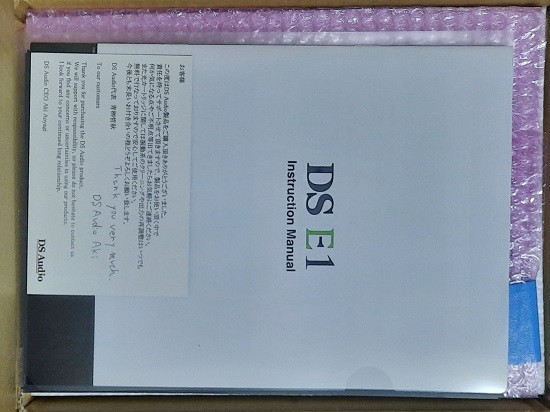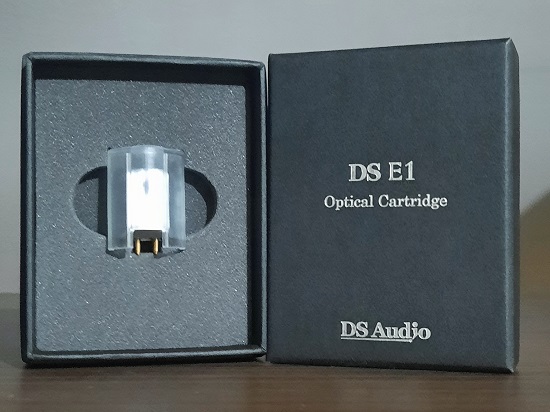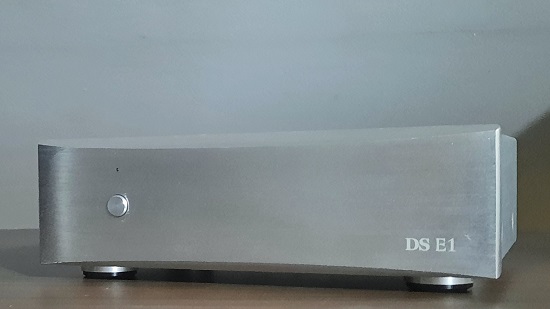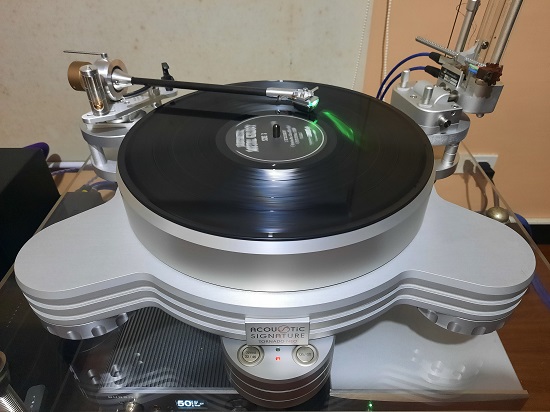The road to nirvana |
|
My journey into Photography, Horology, and Audiophilia |
My first optical cartridge
February 3, 2022
Today, I took delivery of my first optical cartridge made by DS Audio from Japan. It is the entry-level DS-E1 which is the 2nd generation of the technology. The Grand Master and DS-003 are the latest 3rd generation models but the latter is over two times as much and since this is my first venture on a new but old technology, I scrimped.
Unpacking
Opening the box reveals documentation, two brochures (one for you, one for a friend), and a thank you card in a plastic folder.


Taking them out reveals the DS-E1 cartridge in its own box, the equalizer, and a plastic bag containing an allen wrench and two cartridge screws. At the bottom, you'll find the power cord.

You'll find the serial number of your cartridge on the side. One thing I noticed and appreciate Japanese sense of detail is that the serial number also indicates country of destination. This should allow them to easily identify which dealer I got the product from.

The equalizer is about 1.4 kg and as wide as my Gold Note PH-10 so it can easily sit on top of it.

The toggle switch selects Output 1 or Output 2. Output 1 applies 6 dB/octave cut off @ < 30 Hz, and Output 2 adds 6 dB/octave cut-off @ < 50 Hz.

The technical stuff
DS Audio is not the inventor of this technology which existed some 40 years ago from the laboratories of Toshiba, Kenwood, Sharp, and perhaps others. But it is DS Audio that was able to make the technology commercially viable. I am not going to explain how optical technology works because there is a very nice factory tour video by Analog Planet AnalogPlanet Visits Optical Cartridge Manufacturer DS Audio which I encourage you to watch.
Many people are mistaken about the technology and mock it as digital, and they're utterly wrong. If you'd like to read about the principle of operation of the optical cartridge, head over to the DS Audio page Optical cartridge basic principle | (ds-audio-w.biz)
So why DS Audio? Well, price point. I have a limited budget and if I'm going to purchase a new cartridge I'm constrained with the same options, for example Clearaudio Concerto V2, Kiseki Purpleheart, Koetsu Black, Ortofon Cadenza Black, etc. I still own a Clearaudio Concerto and it is my 2nd time of owning them, I also owned a Koetsu Black twice too. I wished for a Phasemation PP-300 but is not available locally.
The DS Audio cartridge pins has the same color nomenclature as standard cartridges but they have a totally different purpose.
- Green (+DC)
- Blue (common ground)
- Red (right channel, -DC bias)
- White (left channel, -DC bias)
So yes, the cartridge is powered by the supplied (or compatible) equalizer and mistakenly installing a standard cartridge connected to the equalizer will surely obliterate the cartridge.
One more thing, be sure that the green and blue wires are not common, or tied up to one another otherwise, it will be a disaster for the equalizer.
Finally, the cartridge output is 50mV which is fed to the DS Audio equalizer to generate an output of 500mV which may be challenge for some systems as the standard expected voltage by most pre-amplifiers is 1V to 2V unbalanced. I had an experience with the iFi Zen Phono owned by a friend wherein the unbalanced output voltage is 500mV that the Hegel H190 failed to amplify with the volume indicator at 50.
From the stock photo on the DS Audio website, it shows that the equalizer is built around JRC 072D JFET operational amplifiers. These are popular DIP-8 chips and is available from other manufacturers such as the TL072 from Texas Instruments. I'm tempted to change the opamps to either a Sparkos SS3602 or Burson Vivid V6 discrete opamps. However, the equalizer sounds excellent already and the chips are directly soldered onto the PCB.
Setting up
Mounting the DS-E1 to the TA-1000 NEO tonearm is no different from any standard cartridge. There are two hex screws and allen tool included in the box. I used the Dynavector 17D2 (died just a week after warranty expired) screws instead, and they work fine.
The published weight of the DS-E1 is 8.1g and the suggested tracking force is 1.7g. I removed the additional weight of the TA-1000 NEO which was necessary when the Koetsu Urushi is mounted. I initially used the HiFi News and Test Record protractor Baerwald 2-point method because my TA-1000 NEO is 9". A hand me down clearaudio digital stylus gauge (AC094) confirms the tracking force at 1.7g.
The equalizer power input is standard IEC but there is no indication of voltage either in the back panel or in the manual, so I made an assumption that it is auto-volt.
Because it's evening already, I connected the output of the DS Audio equalizer to the unbalanced input of my Burson Audio Soloist 3X Performance, set the gain to high, the volume display indicator at 50 and I have plenty of volume. I limit my listening loudness to no more than 80dB whether from speakers or headphones.

On the following day, I was able to connect the DS Audio equalizer to my Qualiton X200 and my apprehension about its 500 mV output is quelled upon hearing the first track. The output voltage from the equalizer is just about the same compared to my Aqua La Voce so it is perfect for me.
Listening impressions
It has to do BABYMETAL right otherwise I'll be disappointed. I completed the 2 LP Metal Galaxy while doing hedoban with a wide grin and the HIFIMAN HE400i on my head. All this time, I forgot to hook in the anti-skate thread of the TA-1000 NEO but it worked fine, no inner groove distortion heard! First impression was how good the PRaT is and I'm happy this has been ticked.

After addressing the senior moment with the anti-skate thread, I replaced the HE400i with the Dan Clark Audio AEON 2 Open then cued in Eva Cassidy Simply Eva 45 RPM 2 LP and I was in for another delightful sonic experience. I can't wait to hear this in my big system!
To cap the night off, I cued in String Band featuring Isao Suzuki wherein the dynamics and nuance gave me goosebumps. It is at this point that I have declared that my money was well spent!
The following day, I was able to hear what the DS-E1 sounds like in my system but I'm not going to list all the albums I played, instead here is my conclusion:
- It's fast, you know this PRaT thing is really a thing. Foot tapping, headbanging kind of PRaT.
- More resolution. Considering that the stylus is elliptical, it can retrieve a little bit of everything from the recording. One reason I'm fond of Clearaudio cartridges is because of resolution, but I also know some people who can't take it, sometimes labeling it as harshness. Well, the DS-E1 delivers resolution without the harshness.
- Soundstage and imaging. With "only" 24dB of channel separation, compared to 30dB of the Clearaudio Concerto, I thought the soundstage and imaging will be affected. But no, the soundstage is as big as before and the imaging is as pinpoint as before.
- Sounds "clean." No, it won't cast magic on those vinyl that accumulated ticks and pops, but on clean vinyl it seems to have lower noise floor.
The DS-E1 is worth every penny for the price of $2,750. Higher up in the chain is an upgrade in price and technology. The 3rd generation DS-003 offers a line contact stylus, 27 dB channel separation, 70 mV output from the cartridge, and discrete equalizer (same 500 mV output voltage).
DS Audio products are distributed by Toyama Inc.